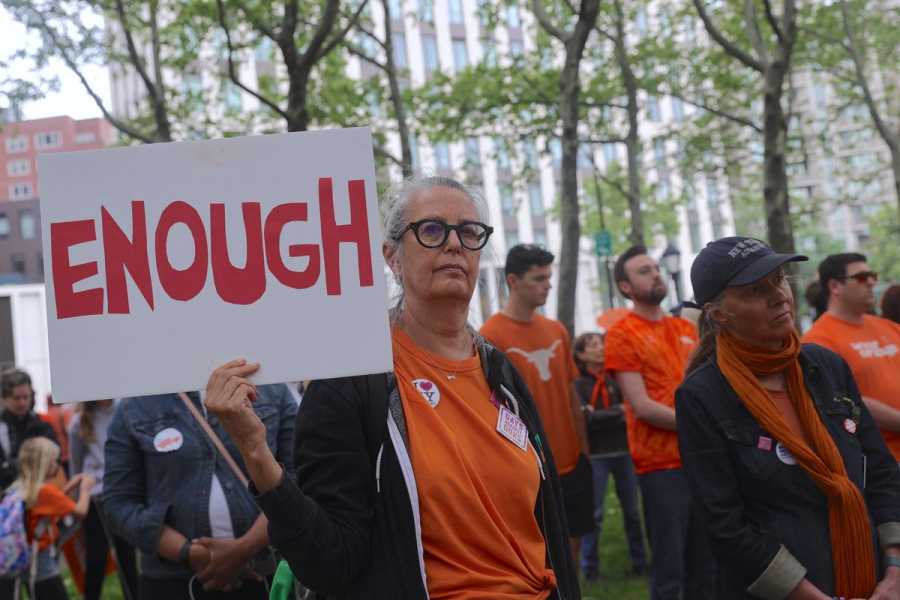The justices are seriously considering whether domestic abusers have a right to own a gun.

Hundreds of people wear orange and march across Brooklyn Bridge in recognition of National Gun Violence Awareness Day on, June 3, 2023 in New York, United States. Selcuk Acar/Anadolu Agency via Getty Images Ian Millhiser is a senior correspondent at Vox, where he focuses on the Supreme Court, the Constitution, and the decline of liberal democracy in the United States. He received a JD from Duke University and is the author of two books on the Supreme Court.
The next gun rights case before the Supreme Court, United States v. Rahimi, involves an individual that no sensible society would allow to have a gun.
Three years ago, according to the Justice Department, Zackey Rahimi and his girlfriend had an argument in a parking lot where Rahimi threatened to take away their mutual child. He then allegedly grabbed her wrist, knocked her to the ground, dragged her to the car, and hit her head on the dashboard. After he realized that a witness had seen this fight, Rahimi allegedly pulled a gun and fired at this bystander.
He later called his girlfriend and allegedly threatened to shoot her if she told anyone that he’d assaulted her.
This is one of a series of gun crimes allegedly committed by Rahimi. In 2020, he allegedly threatened another woman with a gun. According to the Justice Department, “Rahimi also participated in a series of five shootings in December 2020 and January 2021.” In one alleged incident, he “fired into the man’s house with an AR-15 rifle.” In another, he allegedly followed a truck and “fired multiple shots at another car that had been traveling behind the truck” after the truck’s driver flashed their headlights at Rahimi.
Although Rahimi’s lawyers claim that these allegations are “disputed,” they do not deny any of the DOJ’s specific claims. Nor do they offer an alternative version of these events.
Yet last February, a federal appeals court held that Rahimi and other domestic abusers have a constitutional right to own a gun. The Supreme Court will consider whether this decision was correct at a November 7 oral argument.
The federal law at issue in Rahimi allows someone to be disarmed before they are actually convicted of a violent crime. But the law also provides several due process safeguards.
Before anyone can be disarmed under this law, a court must have issued a restraining order against them, in a proceeding where the defendant was given an opportunity to appear and make their case. Federal law does not disarm anyone unless a court has either explicitly determined that they are a violent threat to their partner or to a child, or implicitly made such a determination by prohibiting them from engaging in violence against that partner or child.
Nevertheless, the Fifth Circuit didn’t just strike down this law. It ruled that the law is unconstitutional on its face. That means that, if the Fifth Circuit’s decision is upheld by the Supreme Court, this federal ban on firearm possession by domestic abusers may never be applied to any individual, no matter how violent that individual may be and no matter how careful the court that issued a restraining order against such an individual was in ensuring that they received due process.
And that brings us to the single worst aspect of the Fifth Circuit’s decision in United States v. Rahimi: It was correctly decided. Or, at least, it was correctly decided under the Supreme Court’s incompetently drafted decision in New York State Rifle & Pistol Association v. Bruen (2022), which places an extraordinarily high burden on any government lawyer tasked with defending any gun law in court.
Bruen was supposed to be the crown jewel of originalism — the belief, now ascendant among Republican lawyers and judges, that the only legitimate way to read the Constitution is to determine how it was understood when it was ratified. The Bruen opinion was the six GOP-appointed justices’ attempt to build an originalist framework from the ground up, one that forced judges to rely almost entirely on historical sources when deciding Second Amendment cases.
A little more than a year after Bruen, it is clear that this approach is an unworkable failure that produces deeply immoral outcomes and that has fostered mass confusion within the federal judiciary.
The core question in Rahimi, in other words, is whether the Court will back away from its decision in Bruen, which has led to all kinds of disastrous results, including the Fifth Circuit’s decision holding that abusive husbands have a right to keep a weapon they could use to murder their wives.
How the Supreme Court gave us the Fifth Circuit’s terrible Rahimi decision
Bruen held that, in order to justify nearly any law regulating firearms, “the government must demonstrate that the regulation is consistent with this Nation’s historical tradition of firearm regulation.” This means that lawyers defending even the most widely accepted gun laws, such as the federal ban on gun possession by domestic abusers, must show that “analogous regulations” also existed and were accepted when the Constitution was framed — particularly if the law addresses “a general societal problem that has persisted since the 18th century.” If they cannot, the challenged gun law must be struck down.
This places an extraordinarily high burden on any lawyer defending a gun law. When the historical record is ambiguous or indeterminate, the government loses, and a gun law is effectively repealed by the courts. And lawyers defending gun laws face an especially heavy burden when they defend laws that seek to address a problem, like domestic abuse, that has existed for centuries.
Almost immediately, the Bruen decision sparked mass confusion in the federal courts. Judges have reached contradictory results in a multitude of post-Bruen challenges to gun laws. Courts applying Bruen have struck laws prohibiting guns in places of worship, requiring guns to have serial numbers that allow them to be tracked by law enforcement, and prohibiting underage ownership of guns — all claiming that these laws are inconsistent with “historical tradition.”
And if Bruen is legitimate, Zackey Rahimi must have a constitutional right to own a gun.
Until 1871, when the Alabama Supreme Court ruled that a husband and wife “may be indicted for assault and battery upon each other,” it was legal in every state for married partners to beat their spouses. There is historical evidence that abused women, in at least some parts of the country, were able to obtain court orders requiring their abusers to temporarily turn over money, which would be forfeited if the abuse continued. But there is no founding-era analog to the federal law disarming domestic abusers.
And so the question the Supreme Court must confront in Rahimi is whether a decision like Bruen, with its unworkable legal standard and catastrophic consequences, can be tolerated any longer.
It was obvious the day Bruen was decided that it is unworkable
On the day Bruen was decided, Justice Stephen Breyer warned in a dissenting opinion that, by requiring judges to dive into often-vague and indeterminate historical records, Bruen “imposes a task on the lower courts that judges cannot easily accomplish.” “Courts are, after all, staffed by lawyers, not historians,” Breyer continued. And “legal experts typically have little experience answering contested historical questions or applying those answers to resolve contemporary problems.”
Indeed, Bruen has proved so unworkable — and has led so many judges to such upsetting conclusions — that many of those judges complain openly about it in their opinions. By announcing “an inconsistent and amorphous standard,” complained Judge Holly Brady, a Trump appointee to a federal court in Indiana, “the Supreme Court has created mountains of work for district courts that must now deal with Bruen-related arguments in nearly every criminal case in which a firearm is found.” Another judge slammed the Supreme Court’s Second Amendment cases as “filled with methodological flaws” that invite judges with an axe to grind to selectively find historical evidence that supports the outcome they want to reach anyway, and then use it to justify that result.
Judge Robert Miller, a Reagan appointee, was even more blunt in his assessment of Bruen. After holding that a federal law that prohibits individuals from receiving a firearm while they are under a felony indictment must be struck down under Bruen, Miller concludes his opinion by admitting it “was drafted with an earnest hope that its author has misunderstood New York State Rifle v. Bruen.” Bruen, Judge Miller continues, “insults” the framers by assuming “they were so short-sighted as to forbid the people, through their elected representatives, from regulating guns in new ways.”
Needless to say, sitting federal judges do not typically hurl these kinds of insults at the Supreme Court, as the high Court has more or less unlimited power to sabotage lower court judges’ work.
Bruen relied on a blinkered view of history
One fundamental problem with Bruen, as Judge Miller’s critique of the decision emphasizes, is that the six Republican-appointed justices who joined it appear to have no understanding of why changes in American society over the past 250 years make it difficult or impossible to draw meaningful analogies between modern gun laws and those that existed when the Constitution was written.
Recall that Justice Clarence Thomas’s majority opinion in Bruen announced that gun laws that address a “general societal problem that has persisted since the 18th century” are presumptively unconstitutional unless there is a “distinctly similar historical regulation” from the 1700s. Applying this newly announced rule, Thomas argued that a citywide handgun ban is unconstitutional because “firearm violence in densely populated communities” was a problem that existed at the time of the founding, but 18th-century lawmakers did not address it with a handgun ban.
But the kind of urban communities that exist in modern-day America did not exist in the early American Republic. According to the 1790 census, New York City had only 33,131 residents around the time when the Second Amendment was ratified. The second-largest city, Philadelphia, had fewer than 29,000 residents.
Eighteenth-century lawmakers, in other words, simply did not confront the problem of “firearm violence in densely populated communities” because densely populated communities of the kind that struggle with gun violence in modern-day America did not exist in the 18th century. At the time of the founding, America’s largest city had more or less the same population as modern-day Meridian, Mississippi — the eighth-largest city in the poorest state in the Union.
And yet, because the Supreme Court declared in a majority opinion that urban policymaking in 1790 was closely analogous to governing modern-day New York City, every judge in the country is now bound to follow this absurd conclusion.
Meanwhile, there are countless other ways that America in the 21st century would be unrecognizable to the framers.
For one thing, early America did not have police forces — or, at least, the kind of organized police forces that could enforce modern-day gun laws. While early US communities sometimes relied on citizen “watchmen” to keep the peace and used patrols to track down escaped enslaved people, publicly funded and organized police forces did not emerge until the middle of the 19th century. Many sources claim that the first such police force in the United States was formed in Boston in 1838. New York City formed its police force just a few years later.
When the Second Amendment was added to the Constitution in 1791, in other words, neither the United States nor any state or municipality had the capacity to enforce a law seeking to disarm domestic abusers. But that doesn’t mean that such laws should be declared unconstitutional, any more than modern-day laws regulating the internet are unconstitutional because the framers lacked the ability to send electronic communications.
We simply have no idea how people in 1791 would have regulated guns — or what sort of regulations they would have deemed permissible — if early Americans actually had the state infrastructure necessary to do modern-day law enforcement. Bruen’s inquiry into which kinds of laws existed in a pre-police society tells us nothing about which sort of laws the framers would have deemed constitutional.
Similarly, we have no idea how early American lawmakers would have regulated the kind of advanced weapons that are widely available today, but that did not exist at all — or that were at least very uncommon — when the Second Amendment was ratified.
Indeed, the sorts of firearms that were widely available in the 18th century are not the sort of weapons that were typically used to commit acts of violence against family members or romantic partners. As Ohio State University historian Randolph Roth explained in a 2019 book chapter, “fewer than 10 percent of household homicides” in colonial and revolutionary New England or Maryland were committed with a gun.
The most likely reason why 18th-century firearms were not often used in family violence is that the kind of muzzle-loading guns that were available at the time “could not be used impulsively unless they were already loaded for some other purpose.” These guns could not be kept loaded because the black powder used by these guns would corrode the weapon’s inner workings and would become moist, losing its ability to ignite. Loading such a gun took “at least a minute,” as the user had to “pour powder down the barrel, hold it in place with wadding, and drop or ram the shot or ball onto the charge.”
So one other likely reason why 18th-century Americans did not enact many of the sort of gun laws that exist today is that guns were fundamentally less dangerous in the early Republic. The fact that early Americans did not forbid impulsive men — the sort of men who might murder their wives — from owning a muzzle-loading musket tells us nothing about how the framers might have regulated a weapon that can be stored while loaded, that can be hidden in someone’s pocket or waistband, and that can rapidly discharge more than a dozen bullets.
In fairness, Bruen does acknowledge that cases involving “dramatic technological changes may require a more nuanced approach,” and it does include language indicating that, say, machine gun bans remain viable, even though machine guns were not invented until 1884. Bruen says that “the Second Amendment protects the possession and use of weapons that are ‘in common use at the time.’” So machine guns will remain illegal so long as they remain uncommon.
But the fact that the drafters and ratifiers of the Second Amendment were comfortable living in a world where muzzle-loaded muskets were commonplace tells us nothing about whether they would have also wanted the Constitution to protect weapons that can be carried while loaded and that can turn a mere argument into a murder in less than a second.
The specter of originalism is haunting the Supreme Court
At this point, you might be wondering how six Supreme Court justices — all of them legally trained and well-credentialed — could have embraced a legal framework with such obvious flaws that has been so harshly criticized by judges across the political spectrum. The short answer to this question is one word: “originalism.”
Originalism, in Justice Amy Coney Barrett’s words, is the belief that “constitutional text means what it did at the time it was ratified and that this original public meaning is authoritative.” All reasonable judges believe that it is sometimes useful to inquire into how the Constitution was originally understood in order to decide cases, but originalism, at least in its strongest form, claims that this is the only legitimate way to interpret the Constitution.
Many Republican lawyers, including Thomas, Justice Neil Gorsuch, and Barrett, view originalism as an important part of their identity.
Barrett, at least, also acknowledges two serious problems with the originalist methodology: It sometimes leads to terrible or ridiculous results, and it sometimes produces no result at all. As Barrett wrote in a 2016 article co-authored with scholar John Copeland Nagle, “adherence to originalism arguably requires, for example, the dismantling of the administrative state, the invalidation of paper money, and the reversal of Brown v. Board of Education” — results that, Barrett admits, would “wreak havoc.”
Similarly, Barrett has also acknowledged that originalist methods don’t always produce a clear result, although her answer to how originalists should approach this problem is unsatisfying: “For an originalist, the meaning of the text is fixed so long as it is discoverable.”
Justice Thomas’s biggest innovation in his Bruen opinion is that he figured out a way for originalists to resolve Second Amendment cases even when it is not clear how that amendment would have been understood at the time it was ratified — simply apply a presumption that all gun laws are unconstitutional, and strike down the law unless the government produces sufficient historical evidence to rebut this presumption.
Thomas’s innovation makes a lot of sense if you are an originalist judge who wants to solve the problem of not knowing how to rule on a case if the historical record is indeterminate — provided, of course, that you don’t care one bit what happens to the people of the United States after countless gun laws are struck down. But Bruen does nothing to solve the other problem acknowledged by Barrett’s scholarship: What should an originalist do if their methodology leads to a truly awful and destabilizing result?
A responsible Court would confess that it erred in Bruen and come up with a new framework that can be applied in a sensible and predictable way by lower court judges. (As it happens, in the decade before Bruen, lower court judges came up with a two-step framework for deciding Second Amendment cases that was accepted by every federal appeals court that considered it. The Supreme Court could simply bring that framework back.)
And there is a precedent for the Court swiftly abandoning a disastrous legal framework after a majority of the justices realized it led to disaster.
In Minersville School District v. Gobitis (1940), the Supreme Court upheld a public school district’s decision to expel two students who refused to say the Pledge of Allegiance in class — the students were Jehovah’s Witnesses, and they objected to saying the pledge on religious grounds. Almost immediately after it was handed down, the Gobitis decision triggered a wave of hate crimes against Witnesses, with one Southern sheriff dismissing the violence because “they’re traitors — the Supreme Court says so, ain’t you heard?”
Three years later, in West Virginia State Board of Education v. Barnette (1943), a humbled Court reversed course, holding that the First Amendment forbids the government from forcing anyone to say something they do not want to say.
Will today’s justices show the same humility their predecessors showed in Barnette? Unlikely. But there is a way out of the Bruen dilemma that will allow the six justices who joined that benighted decision to save face, while affirming that the government may enact reasonable gun regulations such as a ban on gun possession by domestic abusers.
Mr. Kavanaugh, tear down this precedent!
Although Chief Justice John Roberts and Justice Brett Kavanaugh both joined Thomas’s opinion in Bruen, they also joined a separate concurring opinion by Kavanaugh, which enumerated several categorical exceptions to the right to bear arms:
[N]othing in our opinion should be taken to cast doubt on longstanding prohibitions on the possession of firearms by felons and the mentally ill, or laws forbidding the carrying of firearms in sensitive places such as schools and government buildings, or laws imposing conditions and qualifications on the commercial sale of arms. …
We also recognize another important limitation on the right to keep and carry arms. Miller said, as we have explained, that the sorts of weapons protected were those in common use at the time. We think that limitation is fairly supported by the historical tradition of prohibiting the carrying of dangerous and unusual weapons.
Kavanaugh added, moreover, that this list “does not purport to be exhaustive,” which implies that he would also endorse other categorical exceptions — perhaps one for domestic abusers, or for people that the legislature has determined are too dangerous to be armed.
This list of Second Amendment carve-outs, moreover, appeared in the Supreme Court’s decision in District of Columbia v. Heller (2008), the Court’s first decision holding that the Constitution protects an individual right to bear arms. And these carve-outs were not added to the Heller opinion because the Court determined that they fit into some kind of originalist framework.
Rather, as Justice John Paul Stevens revealed less than a year before his death in 2019, Justice Antonin Scalia, the author of Heller, added this language after relatively moderate Justice Anthony Kennedy asked for “some important changes” to the original draft of the Heller opinion.
Kennedy is no longer on the Court, but Kavanaugh, his successor, appears to have appointed himself as the keeper of this compromise that Kennedy struck with Scalia. Add on Roberts’s decision to join Kavanaugh’s Bruen opinion, plus the Court’s three liberals, and that’s five votes that are willing to create categorical carve-outs to the right to bear arms which exist outside of Thomas’s originalist framework.
Moreover, while Thomas’s framework supports the Fifth Circuit’s unconscionable decision in Rahimi, Kavanaugh’s framework offers the Court a way to rule that domestic abusers do not have a constitutional right to own a gun. As the Justice Department argues in its brief, the Court can add a new carve-out to Kavanaugh’s list, holding that the Second Amendment permits lawmakers to disarm people who are “not law-abiding, responsible citizens.”
That’s not a particularly satisfying answer to the legal questions presented by Rahimi because it places the Court in the role of an arbitrary policymaker, striking down some gun laws and upholding others because five or more justices think that a new carve-out should apply. But it’s a much more sensible outcome than affirming the Fifth Circuit and allowing abusers to have guns.
The most responsible course the Supreme Court could take, given Bruen’s many flaws, would be to overrule that decision in its entirety and announce a different, more workable framework that courts can apply in future Second Amendment cases — such as the two-step framework that was used by the courts of appeals before the Supreme Court made them abandon that framework in Bruen.
But, since this Supreme Court is unlikely to admit that it erred, Kavanaugh’s willingness to create categorical exceptions to the right to bear arms offers the Court a way to save face while also reversing the Fifth Circuit’s terrible Rahimi decision.
Sourse: vox.com






